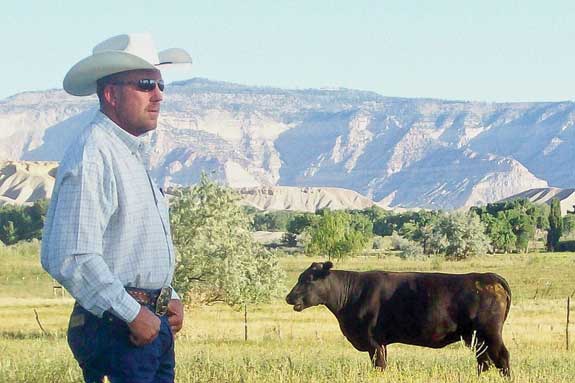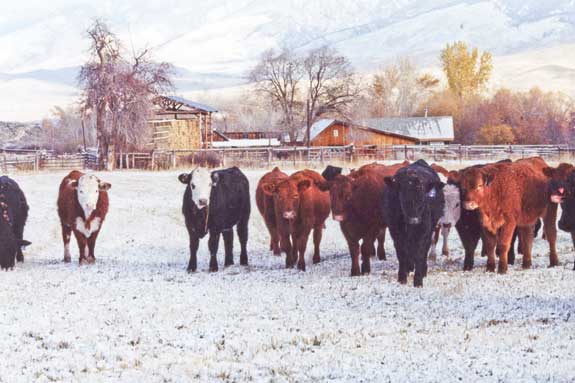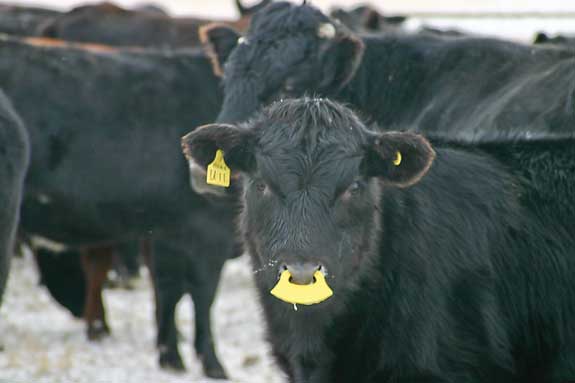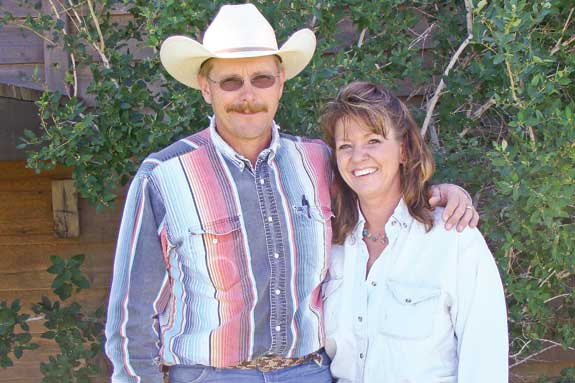The goal is to wean with least stress – to keep calves healthy – and get them gaining again as soon as possible.
Vaccinations
Monroe Magnuson raises Angus and Chiangus composite cattle in southeastern Utah and says he doesn’t follow the same weaning practices every year, because every year is different.
“Some years we’ve had extremely warm weather late into the fall, and then it gets cold quickly. Last year we had moisture that we hadn’t planned on. All these things affect weaning,” he says.
“The most important thing when weaning is to vaccinate calves at least 10 days to two weeks beforehand,” he says. “This pays big dividends.
People who don’t do this usually say it’s too expensive, but depending on the size of their herd, they could probably pay for the whole vaccination program with the cost of one lost calf.”
Fenceline weaning
“The times I’ve had the most luck weaning calves is when I put them on a preconditioning program like a self-feed ration and get them bunk broke while they’re still on the dam,” says Magnuson.They learn to eat the feed before they are weaned.
“I don’t know if the way I wean can actually be called fenceline weaning, but the calves have access to their mothers through the corral fence.
They get past weaning quickly. If calves are bunk broke and know their mothers are nearby, they don’t stress over it very long,” he says.
Kim and Scott Ford raise registered and commercial Red Angus near Bertrand, Nebraska, and pasture-wean. “We used to do it the hardest way possible,” says Scott.
“We’d gather the cows and sort them off, throw the calves in trailers and haul them to corrals where we’d feed them for three to five days, then let them out in a pasture,” he says.
“We try to keep a pasture for the calves; we might graze it once, early in the season, and let it regrow,” Scott explains. “At weaning, we bring the cattle into that pasture, so they pair up and nurse.
The next day we put up a portable corral and go out with our cake pickup, to get the cows to group up. Then we lead them through the gate, at a pretty good clip, and we hardly have to sort.The cows are all following the truck, and we just sort the last few.
“With the cows sorted off, we run the calves through the chute and give them a booster of the vaccine we gave three weeks earlier.”
Then the calves are left in the pasture, adjacent to their mothers, separated by a five-strand fence half a mile long, with one hot wire. There are two water tanks in the fenceline, so when calves are walking the fence they easily find the water.

Introducing grains
Ford says he starts giving the pairs a little dried distillers grain every two or three days, about two weeks before weaning.
“We drive out with the pickup, blow the siren and spread the dried distillers on the ground. The cows come to eat, and the calves try it and learn how to eat it.
They know that Mom thinks it’s good, and they make that association when Mom runs to the pickup. They learn quickly, by watching their mothers.
“When we take them away from the cows, we start feeding the calves distillers grain and by the third day they are basically weaned.
They’ll go find Mom at the fence and bawl at her a few minutes, then walk away and graze. The calves are not stressed because they know Mom is there, and we haven’t changed the calves’ feed.”
The calf has fresh grass, water and a little distillers grain. “He nursed in that pasture before you took Mom away, so he’ll go to the last place he nursed or go to the fence to find Mom.
Calves are not trying to crawl out, because this is the last place they were with their mothers,” says Ford.
“On the third day we take the cows to cornstalks. Once the cows are gone, the calves aren’t worried about them anymore. Every morning when we feed the calves, we gather them. It’s good to check them, and bring them into feed.”
Fenceline weaning has made labor much simpler and healthier, Ford says. The cows and calves are not in a dusty corral and don’t have respiratory problems. “It is very low-stress,” says Ford.

Corral weaning
Jim Jensen of the Lucky Seven Angus Ranch in Wyoming gives pre-weaning vaccinations about three weeks ahead of weaning.
He weans calves in big lots, and instead of putting feed in bunks, as he used to do, he places several big bales along the fenceline, about 10 feet away from the fence.
They start circling and pacing the fence, looking for a hole, wanting to find a way out to get back to their mothers, and find something to eat as they travel.
“If you have the feed in a bunk, they’ll never eat. They just walk by it. If bales are scattered along the fence, every time they walk by one of the bales, they’ll grab a bite.
They’ll run by and get a mouthful, then go to the next bale and eat a little more. They eat as they keep circling,” he explains.
The big bales serve two purposes: They help slow the calves so they aren’t just running back and forth along the fence, and entice them to eat more.
“This is much better than trying to feed them in bunks. Sooner or later they’d find the bunks, but it took some calves two or three days before they’d get a mouthful. Now they don’t back off from feed very much,” he says.

Nose flaps
Mark Ehlke raises registered Herefords and a few Angus near Townsend, Montana. Last year he tried a new weaning method, using commercial nose flaps in the calves.
“I was somewhat skeptical, but now I am a believer,” he says. “It’s a little labor-intensive putting them in, and a few came out. We had to put about a dozen of them back in, out of 200 calves.”
The plastic flaps can be easily installed with calves restrained in a chute, and then the calves are returned to their mothers.
The flap hangs down over nose and mouth, preventing the calf from getting a teat into his mouth to nurse, but does not hinder eating grass/hay or drinking water.
The calf cannot nurse, but is not emotionally upset because he has her companionship during the weaning process.
The cow starts to dry up, and the calf adjusts to not having milk. About five to seven days later, cows and calves can be completely separated (and the flaps removed), and the calves are not stressed.
“Those calves went right to feed, coming off the cow, with no roaming or pacing the fences,” says Ehlke. They were already adjusted to not having milk.
“We left the nose flaps in a little longer than recommended, but it worked well. We decided a few extra days wouldn’t hurt, so we gave the pre-weaning vaccination and put nose flaps in at the same time.
This saved one trip through the chute. So most of the flaps were in for two weeks,” says Ehlke.
Then the pairs were separated and calves taken to corrals to be put on feed. “As we were unloading at the corrals, we took the flaps out of the calves as we let them out of the trailer,” he says.
Thus there were no extra trips through the chute to deal with the nose flaps.
“We’ll definitely use this weaning method again. The flaps are re-usable, so you only have that investment the first time. Last year, with the flaps, was the best year ever, as far as our calves going to feed and the weight we put on them.”
Ehlke said nose flaps create the least stress on calves, even less than fenceline weaning, because they are right with their mothers.
“They get a little grumpy because they can’t nurse, but they’re not upset like they would be if the cow was gone,” says Ehlke.
This method could revolutionize weaning for many ranchers, especially if they want to try low-stress weaning and don’t have adequate facilities for fenceline weaning.
Being able to keep calves with the cows and have them fully weaned when you take them away is a big plus. Weather is always a gamble at weaning time, but this weaning method would not be added stress, like it is when calves are weaned abruptly.
“Once we take the cows away, we feed the calves a weaning pellet for 28 days and then go to a grower feed. With this new method of weaning, we don’t have any slowdown in their gaining,” says Ehlke. ![]()

PHOTOS
Top: Scott Ford (pictured) and his wife Kim use pasture weaning on their Red Angus herd, using distillers grain with the calves. Photo courtesy of Scott and Kim Ford
Top Middle: Monroe Magnuson takes a different approach to weaning each year on his Castle Dale, Utah ranch, with varying weather patterns. Photo courtesy of Monroe Magnuson
Middle: Weaned calves Photo by Heather Smith Thomas
Lower Middle: Plastic nose flaps prevent a calf from sucking but not from eating hay or drinking water. Photo by Heather Smith Thomas
Bottom: Mark and Della Ehlke of Townsend, Montana discovered nose flaps made weaning less stressful by keeping calves with mothers. Photo courtesy of Mark Ehlke








